NUTR*3210: First Half
1/289
There's no tags or description
Looks like no tags are added yet.
Name | Mastery | Learn | Test | Matching | Spaced |
|---|
No study sessions yet.
290 Terms
nutrition
The science of:
Food
Nutrients and substances in food
Their action, interaction, and balance in relation to health and disease
The processes by which an organism:
ingests, digests, absorbs, transports, utilizes, excretes food substances
Optimizing health and preventing disease
How are nutrients getting in and out (transport mechanisms, metabolism processes)?
essential nutrient
A chemical/substance that is required for metabolism, but cannot be synthesized or cannot be synthesized rapidly enough (in the body) to meet the needs of an animal or human for one or more physiological needs.
How are they identified?
Removing the nutrient (long-term) causes a deficiency and decline in health.
Putting the nutrient back (consistently, long-term) corrects the problem and health will return.
nutritional deficiency
Occurs when a person’s nutrient intake consistently falls below the recommended requirement (chronic, long-term depletions).
Basis to measure prevention of disease - how much of a nutrient do we need to consume to prevent a disease? Does not necessarily relate to optimal health.
Common for iron, folate, Vitamin B12, thiamine (Vitamin B1), Vitamin C, and Vitamin D.
nutritional requirements
Range of nutrient intakes required by individuals in a population subset (e.g. specific age group or gender) to achieve the same end point of growth, storage, or health.
Must take into consideration the Estimated Average Requirement (EAR) and the Recommended Dietary Allowance (RDA).
Daily Values (DV)
A simplified way to provide consumers with information about the daily requirement for each nutrient.
→ How much will the product contribute to our macro/micronutrient intake?
Based on a 2,000 Calorie-a-day diet; many people will need more or less - good tool as a guide for the general population, but needs tweaking for individuals based on their gender, age, etc.
Made using Dietary Reference Intakes (DRIs).
Dietary Reference Intakes (DRIs)
An umbrella term that refers to a set of reference values of nutrients (EAR, RDA, AI, and UL). Introduced in 1997.
Established by the National Academy of Sciences (private, non-profit org made of US and Canadian scientists) using published data.
Estimated Average Requirement (EAR)
The concentration of nutrients that meets the needs of 50% of the population.
Recommended Dietary Allowance (RDA)
The concentration of nutrients that meets the needs of ~97% of the population.
= EAR + 2(STD DEV)
Tolerable Upper Limit (UL)
The highest level of continuous daily nutrient intake that causes no risk of adverse effects.
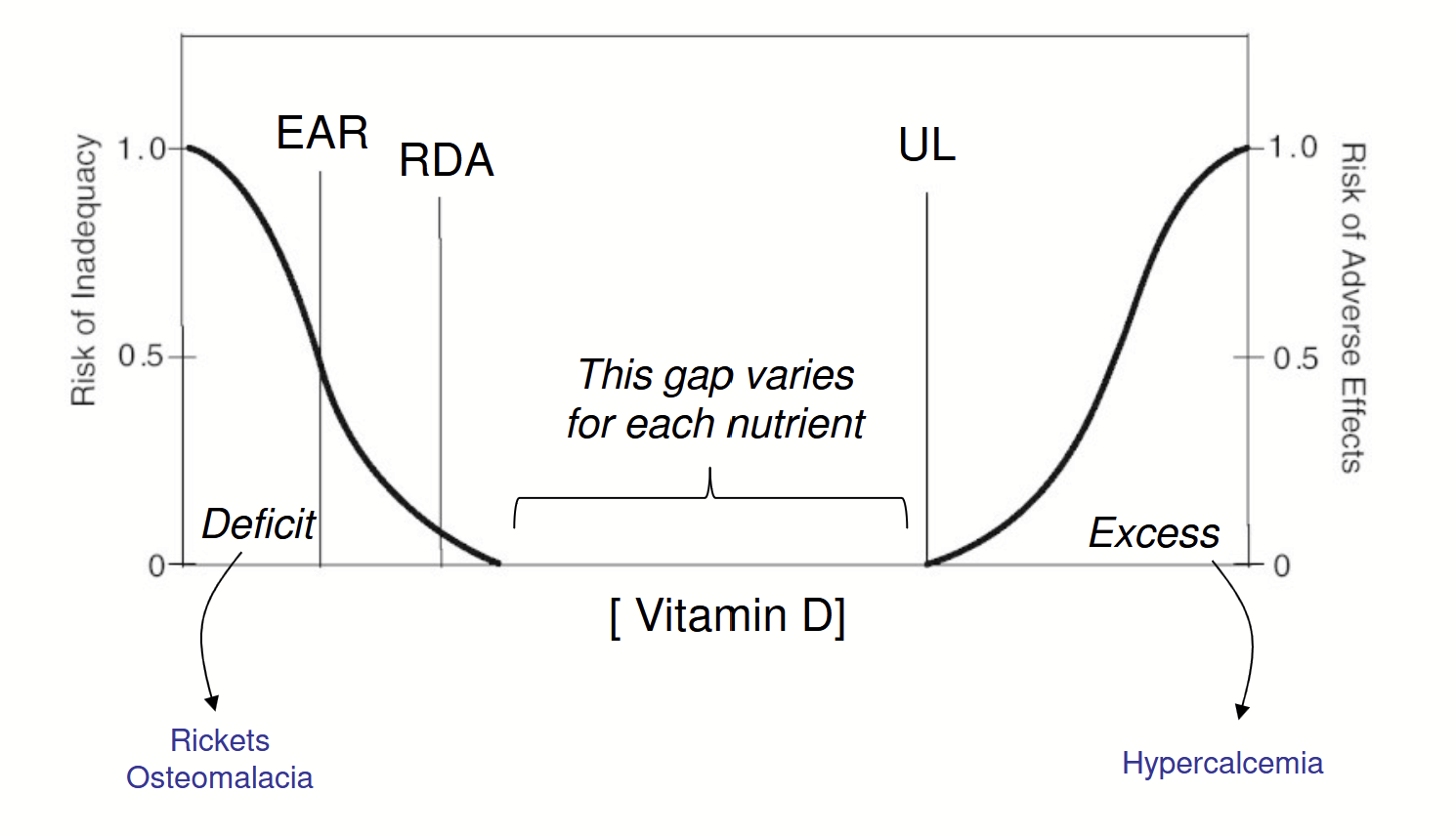
Adequate Intake (AI)
Proposed when sufficient scientific evidence is not available to establish an Estimated Average Requirement (EAR) and Recommended Dietary Allowance (RDA). Based on much less scientific data.
Determined based on intake in healthy people who are assumed to have an adequate nutritional status (i.e., normal blood levels of a nutrient).
Is expected to meet or exceed the needs of most individuals.

starvation
Outcomes: weight loss, irritability, dizziness, tiredness, hair loss, reduced sex drive, depression, etc.
Some of these required over two years to be fully rehabilitated!
nutritious diet
Diet must provide enough nutrients, but not too many. It must have four characteristics that have distinct meanings:
Adequate
Moderate
Balanced
Varied
adequate
One of four characteristics of a nutritious diet.
A diet that provides enough Calories, essential nutrients, and fibre to keep one healthy.
moderate
One of four characteristics of a nutritious diet.
Ensuring that one does not consume excessive Calories, or eat more of one food / food group than recommended.
balanced
One of four characteristics of a nutritious diet.
Making sure one eats nutrient-dense foods, rather than nutrient-poor foods.
varied
One of four characteristics of a nutritious diet.
Eating a wide selection of foods to obtain the necessary nutrients. Needed to fulfill the rest of the characteristics of a nutritious diet!
the study of nutrition
Using various models:
Cell culture models
Animal models (rodents, pigs, etc.)
Human studies
Epidemiological cohort studies
Prospective (intervention; looking into the future) vs. Retrospective (looking back in time to see what led to present)
Intervention studied
Randomized Control Trial (RCT) → 2 groups randomly allocated to different conditions
Challenges: genetics, lifestyle, cultural habits, etc. → WE ARE ALL DIFFERENT!
nutrient classes
Macronutrients and micronutrients.
Organic nutrients and inorganic nutrients.
organic nutrients
Class of nutrients that contain carbon.
Carbohydrates (& fibre)
Lipid
Protein
Vitamins
inorganic nutrients
Class of nutrients that do not contain carbon.
Minerals
Water
macronutrients
Class of nutrients that we eat a lot of!
Carbohydrates (& fibre)
Lipid
Protein
micronutrients
Class of nutrients that we eat a little of!
Minerals
water
Not commonly known as a “nutrient”, but extremely important for health. Considered an inorganic nutrient, but neither a macro nor micronutrient.
Intake by adult humans: 2.7-3.7 L/day (on average, 20% from foods). Primarily stored intracellularly.
Functions:
Solvent in biochemical reactions
Catabolism (hydrolysis)
Maintains vascular volume
Nutrient transport (solubility, etc.)
Temperature regulation (sweating, etc.)
metabolism
Anabolism (energy in) + Catabolism (energy out). Constantly ongoing, good at recycling nutrients.
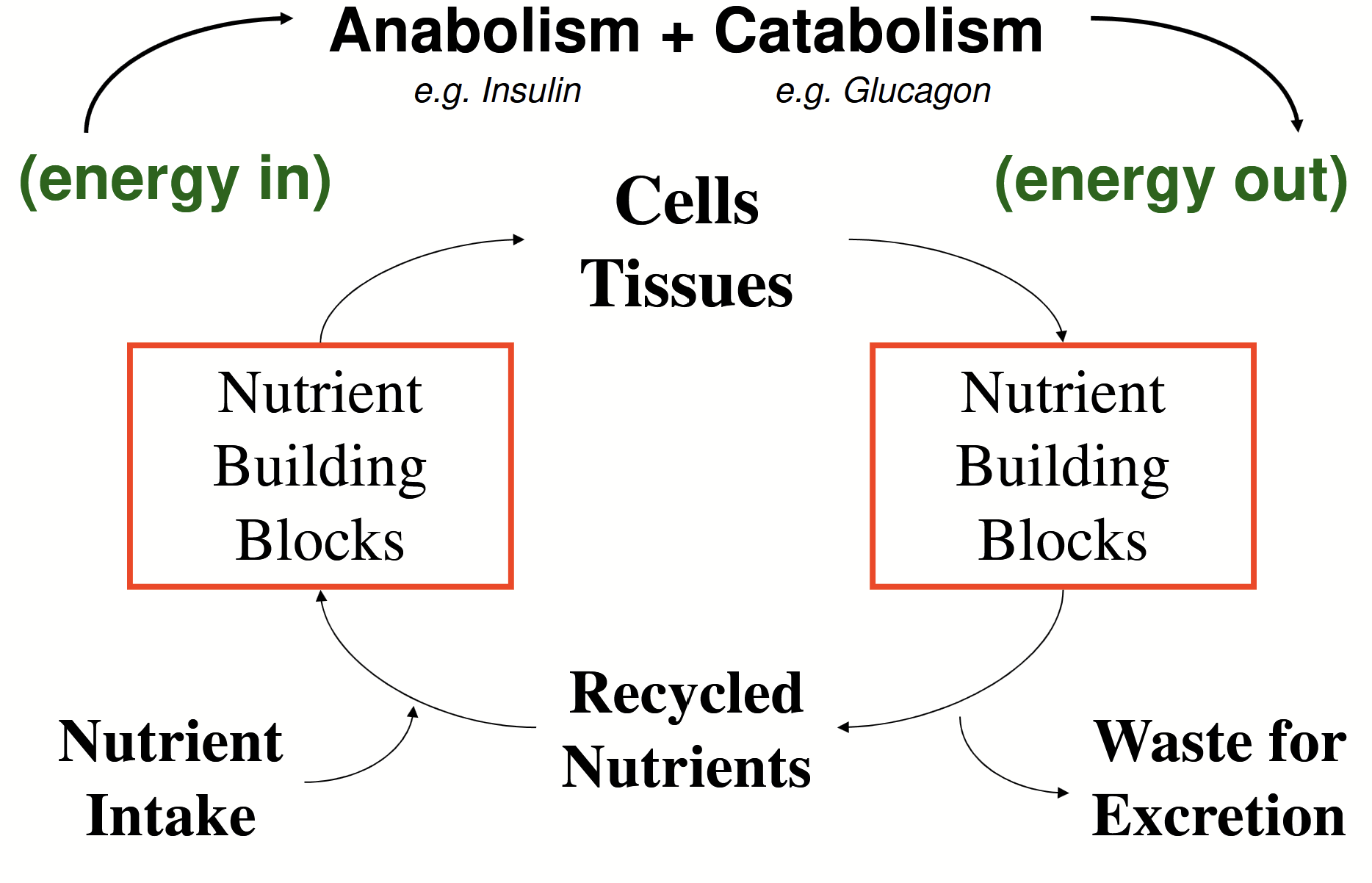
water toxicity
Water intake >>> kidney’s ability to process (~0.9 L/h).
Leads to imbalance between electrolytes (particularly sodium) and water.
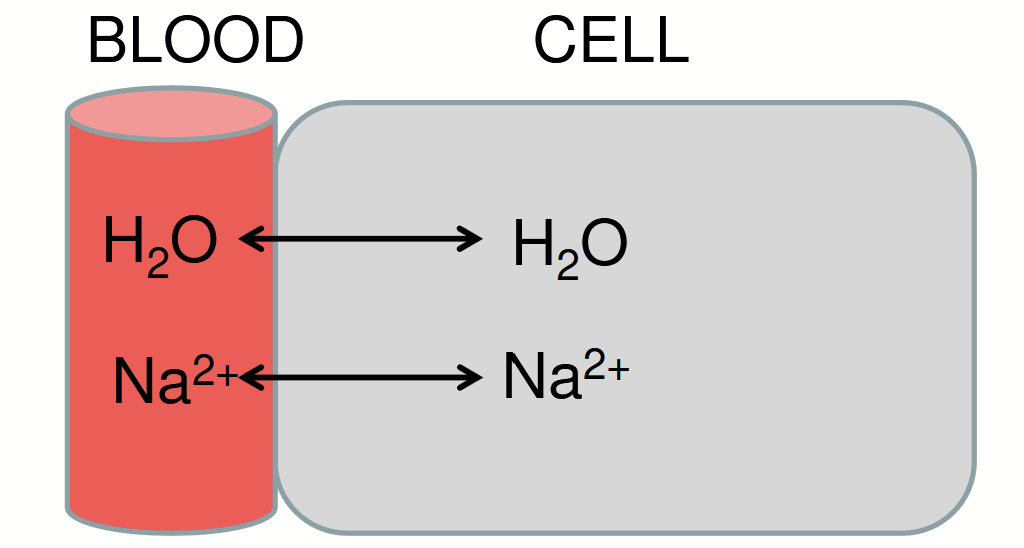
hyponatremia
Water / sodium imbalance (abnormally low concentration of sodium in blood).
Can occur from excessive fluid intake, under-replacement of sodium, or both. Typically avoided with urination (often happens if body is forced NOT to urinate).
Causes central nervous system edema and muscle weakness - can lead to death.
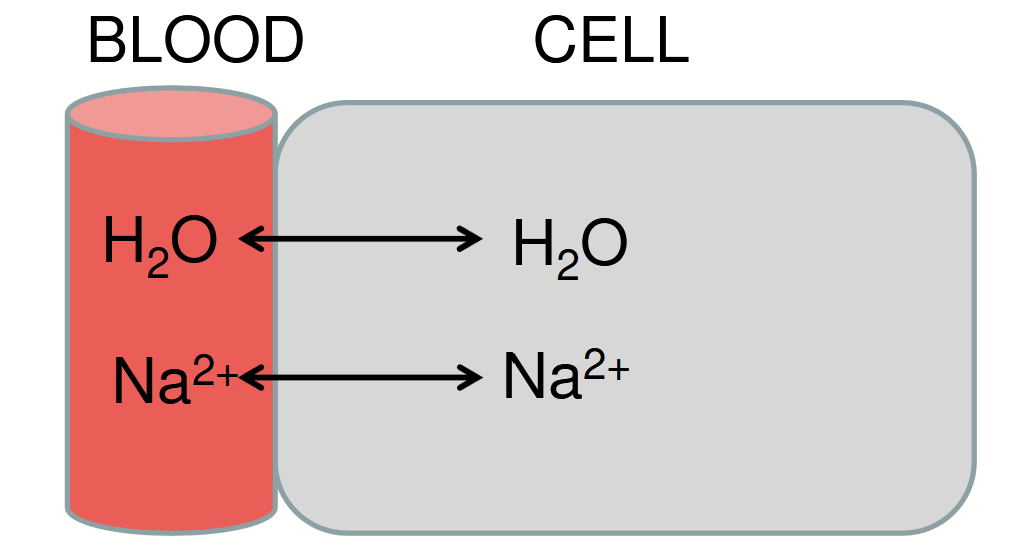
food analysis
The development, application, and study of analytical methods for characterizing foods and their constituents.
Shares information about foods, produces foods that are safe and nutritious, allows the customer to make informed decisions.
Government regulations: maintain quality of foods, safe and high quality foods, ensures fair competition, eliminates economic fraud
Quality control: ensure food composition doesn’t change, characterize raw materials
proximate analysis
An analytical technique from the mid-1800s that provides crude ideas to the nutritional components of food. Still used today, with exceptions, as results are not very accurate.
Has six components: moisture, ether extract, ash, nitrogen, crude fibre, and nitrogen free extract (digestible carbohydrate content).
Still used as the basis for human food labelling and animal feed analyses, but…
No information on the “digestibility” of food/feed - we don’t know what will actually be absorbed by an organism
No information on specific amino acids, minerals, lipids, or carbohydrates (consumers want this info) - as such, more advanced analytical assays have been developed.
moisture (water content)
Water = weight and is part of the price of feed; must also be shipped (more water = higher costs)
Plays a role in storage conditions
Too much, food will spoil quickly (encourages bacterial growth)
Too little, food will be less palatable (too dry)
Dilutes energy and nutrients in food (the more there is, the less nutrients per unit)
Important for optimum intake and performance of animals
Human food labelling is based on wet weight
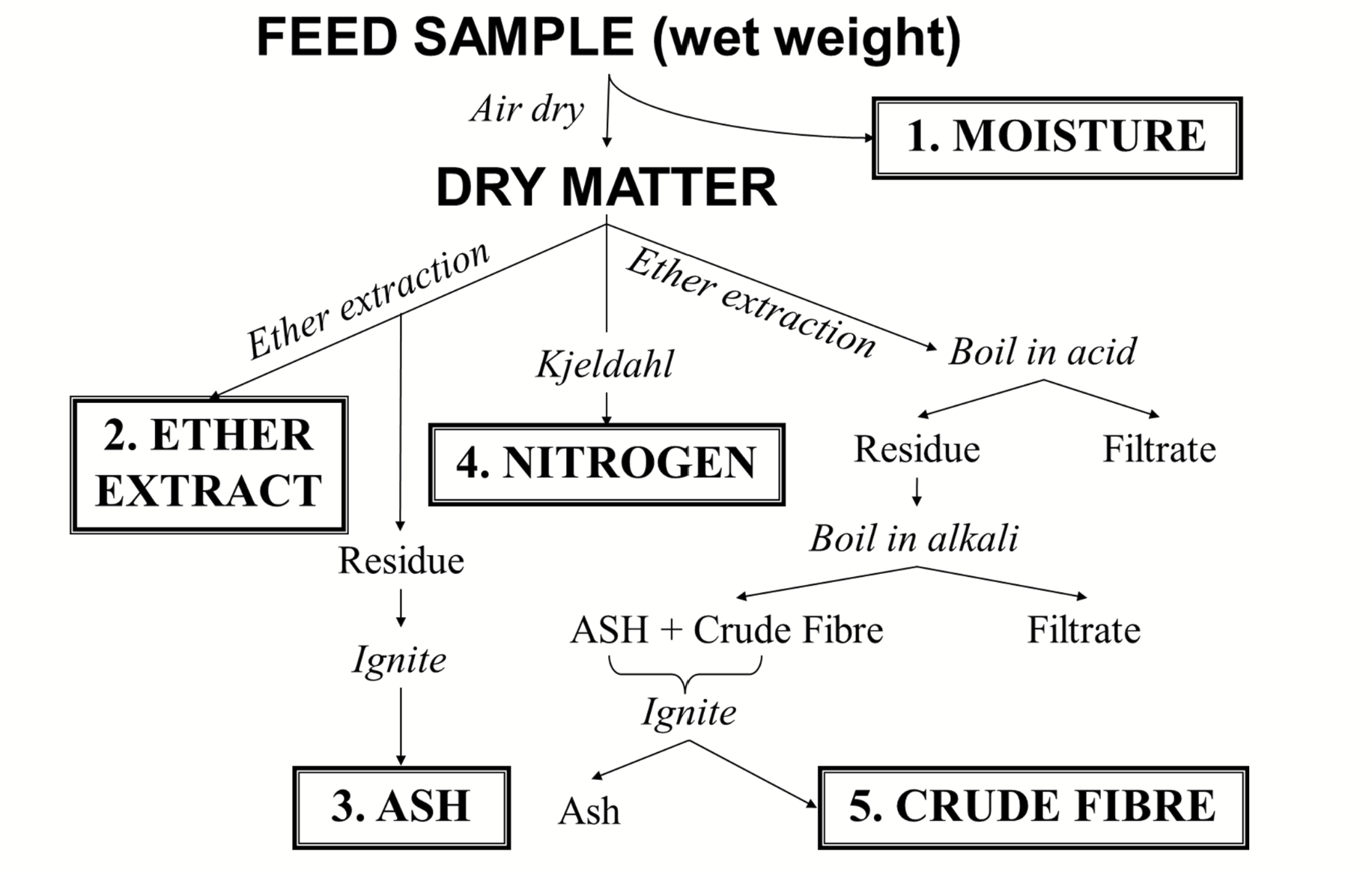
% moisture

dry matter
Potential sources of error/limitations:
Drying can remove other volatile compounds, such as short chain fatty acids (SCFAs) and some minerals (when heated, will degenerate)
This can cause a slight under-estimation of dry weight
Agricultural industry is more interested in this composition!

ether extract (fat content)
Dispense dry matter into an organic solvent. The solution is transferred to a new tube and then dried down. The fat goes into solution, and everything that is not a fat will precipitate out.
Potential sources of error/limitations:
Other things are soluble in organic solvents (things that are NOT nutrients)!
e.g. chlorophyll, resins, waxes in plants
This could over-estimate crude fat determination!
% crude fat

gas chromatography
A newer method to estimate the % crude fat.
Used to tell us how much saturated vs unsaturated fat there is!
Government-mandated!
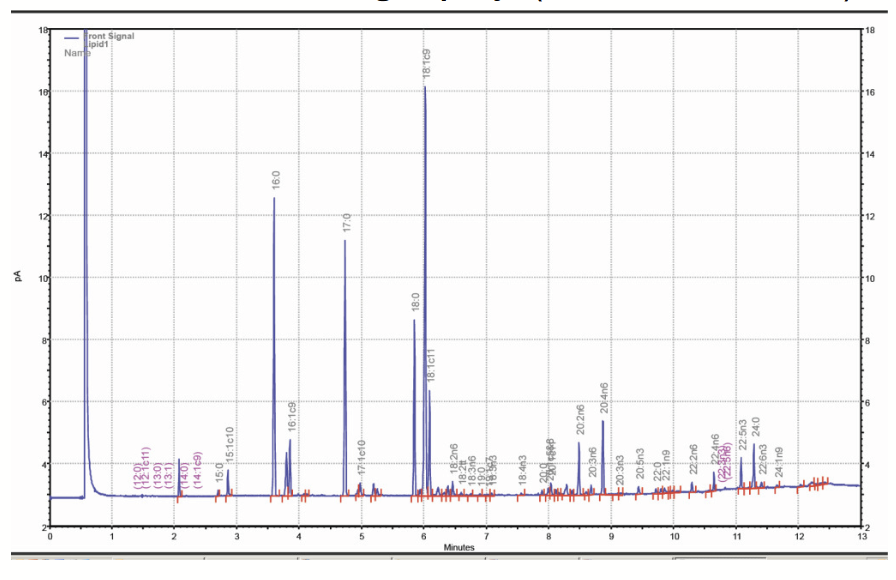
Ash
Remove solution extract from ether extract. Burn the precipitate at ~500-600°C. Anything organic is burned off and only the mineral content is left.
Important for nutritional labelling, quality and taste of food, microbiological stability, nutritional requirements, and manufacturer processing.
Potential sources of error:
Volatile minerals may be lost when burning the residue (e.g. Zinc)
No information about individual minerals; not specific
It is now mandatory for food labels to indicate sodium content!
% ash

nitrogen (protein content): Kjeldahl analysis
Assume:
All nitrogen is in protein
All protein contains 16% nitrogen → not actually true, is actually a RANGE.
Steps:
Digestion: a food sample is mixed with sulfuric acid, which converts nitrogen into ammonia.
Distillation: separates the ammonia.
Titration: quantifies the amount of ammonia.
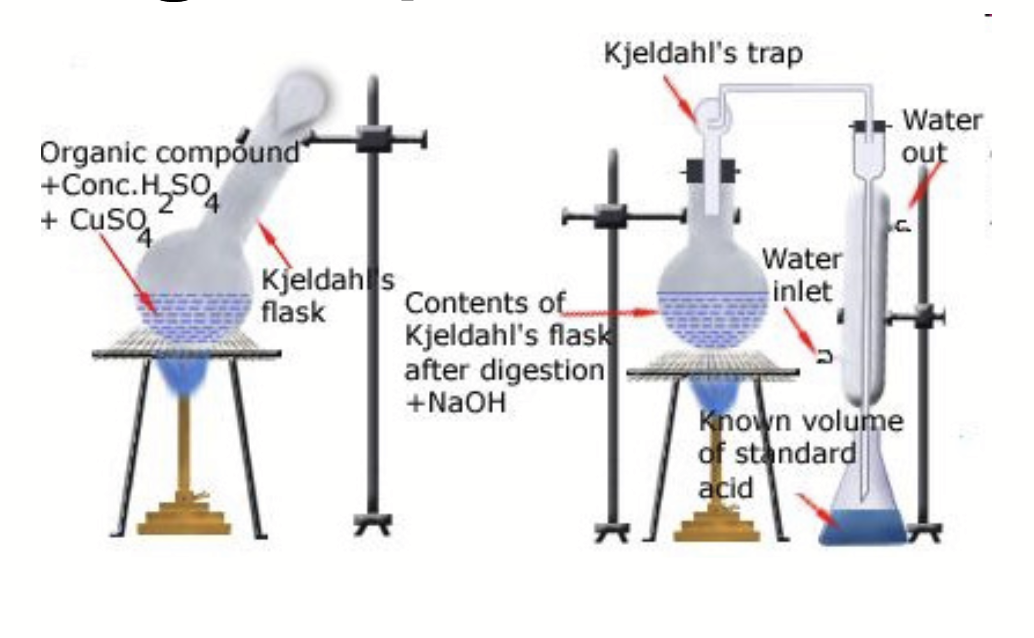
% crude protein

Kjeldahl analysis
Potential sources of error/limitations:
Assumes all proteins have 16% nitrogen.
Actual range is 13-19%
e.g. peanuts have ~18% N; conversion factor = 5.5
e.g. milk has 15.7% N; conversion factor = 6.38
Other sources of nitrogen.
Any nitrates, nitrites, urea, nucleic acids, etc. in the food sample would therefore be part of the crude protein calculation → this would slightly over-estimate the crude protein content.
crude fibre
Mainly tells us about the cellulose and lignan content (i.e., insoluble fibres).
Dry weight → Ether extraction → Boil in acid → Residue and Filtrate → Boil RESIDUE in alkali → Ash + CF + Filtrate → Ignite → CF.
Potential sources of error/limitations:
Unable to distinguish different fibre components
Measuring under-estimates the actual dietary fibre content of feed up to 50%
Dietary fibre includes cellulose, hemicelllulose, pectin, mucilages, gums, lignan, etc. Soluble fibres are lost during proximate analysis.
% crude fibre

dietary fibre
Non-digestible complex carbohydrates (CHO); structural part of plants. Describes all fibre (both soluble and insoluble) in a food.
Divided into insoluble and soluble:
INSOLUBLE: cellulose, lignan, hemicellulose.
Remains intact through intestinal tract (do not dissolve in water).
Lowers bacterial growth, alleviates constipation, sustains gut microbacteria.
SOLUBLE: pectins, gums, mucilages.
Forms gel (dissolves in water).
Bind onto other nutrients (e.g. cholesterol, glucose) and increase the rate at which they are absorbed (e.g. prevents cholesterol buildup).
To additionally determine the content, additional analyses are necessary.
Nitrogen Free Extract (NFE) (Digestible Carbohydrate Content)
Estimates starch and sugar content (the nutrients that we have enzymes to break down); a mathematically-derived value.
Potential sources of error/limitations:
Accumulates ALL of the errors that exist for the other components → probably the greatest error!

Van Soest Method (detergent fibre analysis)
Fibre analysis that differentiates between insoluble fibres:
Cellulose and hemicellulose
Lignan (poorly fermented, prevents fermentation of other fibres)
Determines fermentable and non-fermentable CHO (whether or not the bacteria of the host organism have the enzymes to break it down).
Very important for agricultural applications!
Not used for human food analysis because it poorly differentiates sugars, starches, and soluble fibres.
lignan
An insoluble fibre that is poorly fermented. It prevents the fermentation of other fibres.
The more there is, the more interference with other fibres!
Southgate Method
Fibre analysis that provides information about sugars, starch, and various fibres.
Useful for human nutrition and food labeling.
Does not differentiate sufficiently between various insoluble fibre components adequately (as we cannot digest them), so this method is not used for agricultural applications.
Newer methods now exist that are used to report on the amount of fibre in a sample!
gastrointestinal tract (GIT)
Commonalities: mouth, esophagus, stomach, small intestine, large intestine, caecum, rectum.
digestive system
Refers to the GI Tract AND associated organs (liver, pancreas, gallbladder).
solubility
Is a CHO soluble in the aqueous environment of the digestive tract? Determined by physiochemical properties of CHO.
Yes → will be in a gel solution. No → moves through GIT, untouched.
digestibility
Does the host organism have the enzymes necessary to digest a CHO? Determined by host digestive enzymes.
Digestible CHO vs non-digestible CHO (fibre).
fermentability
Do gut bacteria have the enzymes necessary to break down a CHO? Determined by gut bacteria.
simple digestive system without caecum
Key features:
Monogastric (simple stomach)
Non-functional caecum
Considered a hindgut fermenter (fermentation takes place in the large intestine, after the small intestine where nutrient absorption happens)
Suited for a nutrient-dense, low fibre diet.
e.g. human, pig, cat, dog
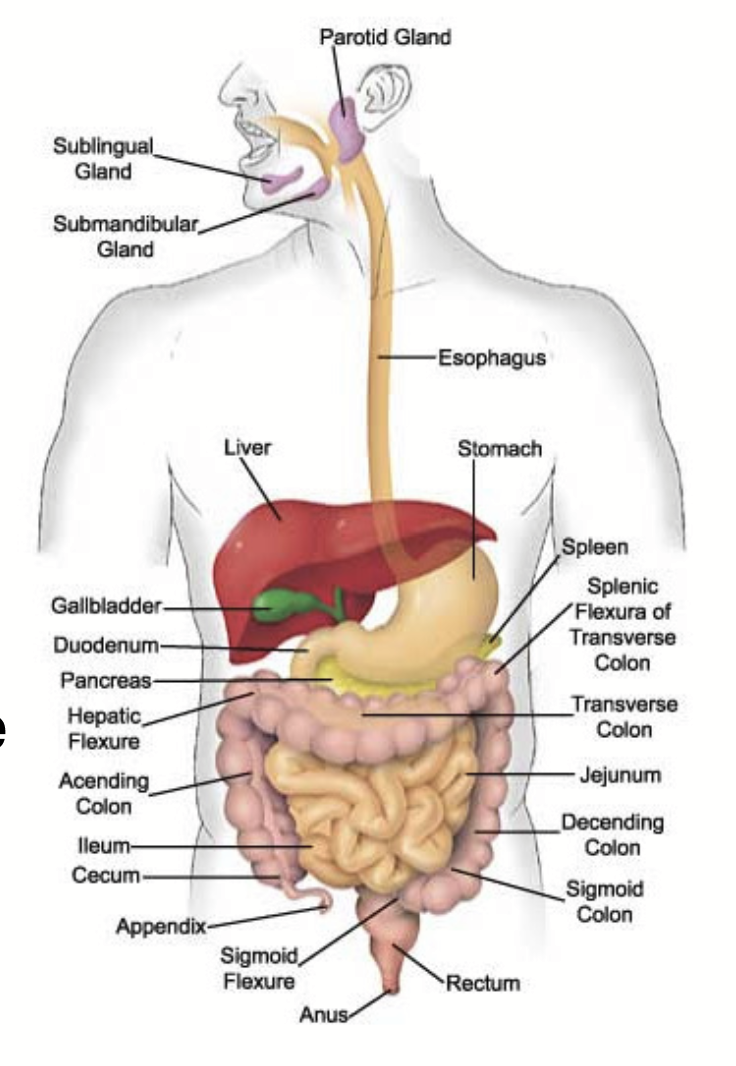
oral cavity
Food is chewed (mechanical breakdown) and mixed with saliva.
Salivary glands release two enzymes:
α-amylase: breaks down CHO
lingual lipase: breaks down TAGs (fats)
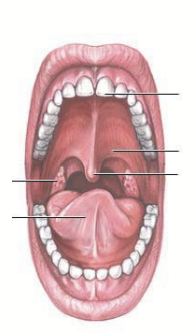
stomach
Has four non-visually distinct regions that are made up of different cell types: cardia, fundus, body, antrum.
Empty = 50mL. Filled = 1-1.5L. Gastric emptying = 2-6 hours.
pH is acidic, ~ 2
Food becomes “chyme” (mixture of gastric enzymes, gastric liquid, food)
Gastric glands secrete gastric juice:
H2O, electrolytes, HCl, enzymes
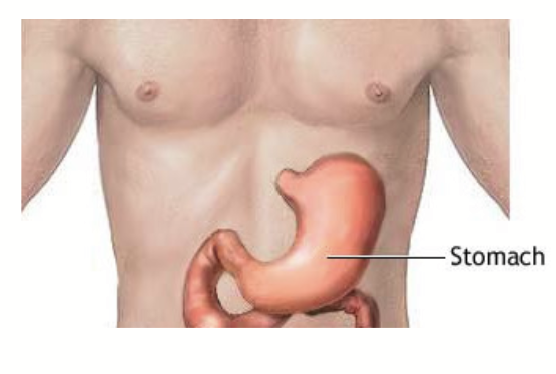
gastric juice
Secreted by gastric glands into the stomach. Made up of H2O, electrolytes, HCl, and enzymes.
chyme
A mixture of gastric enzymes, gastric liquid, and food, found in the stomach. Has an acidic pH (~ 2).
small intestine
Composed of three non-visually distinct regions, each having different cells types and muscles: duodenum, jejunum, ileum. Surface area = 30m2
Main site for nutrient digestion and absorption (the nutrient gateway).
Intestinal motility controlled by longitudinal (squeezes fluid down) and circular (contricts) muscles.
Chyme acidity is neutralized by pancreatic juice (which contains bicarbonate).
Food is digested by pancreatic juice and bile acids (made in liver, stored in gallbladder).
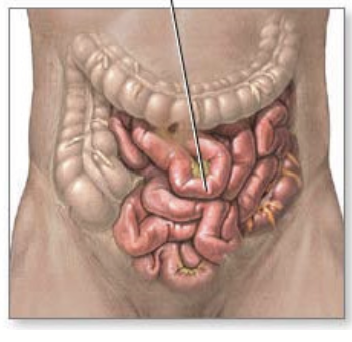
large intestine (colon)
Site of fermentation - where all bacteria are. Gut bacteria have enzymes to break down non-digestible food.
Production of short chain fatty acids (SCFA), which are also known as volatile fatty acids (VFA). Provide energy to bacteria and some to the host.
Site for water absorption.
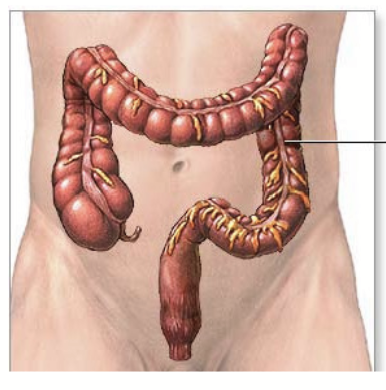
Kerckring folds
Create more surface area in the small intestine to enhance nutrient absorption.
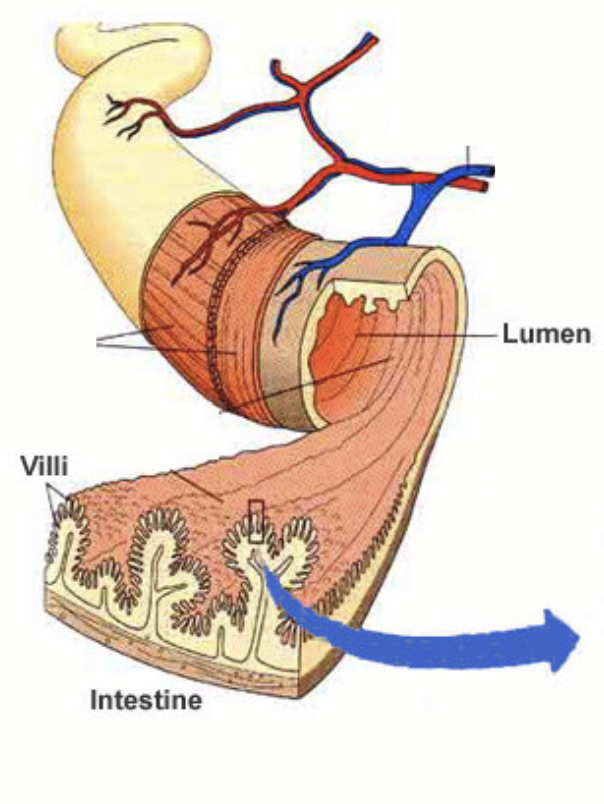
villi
Protrusions on the Kerckring folds in the small intestine that resemble little fingers. Have different types of cells involved in the absorption of different types of nutrients.

crypts
Indentations on the Kerckring folds in the small intestine that resemble little fingers. Have different types of cells involved in the absorption of different types of nutrients.

microvilli
Protrusions on the villi in the small intestine to further increase surface area for nutrient absorption. Found in each epithelial small intestinal cell.
Also called the “brush border membrane”.
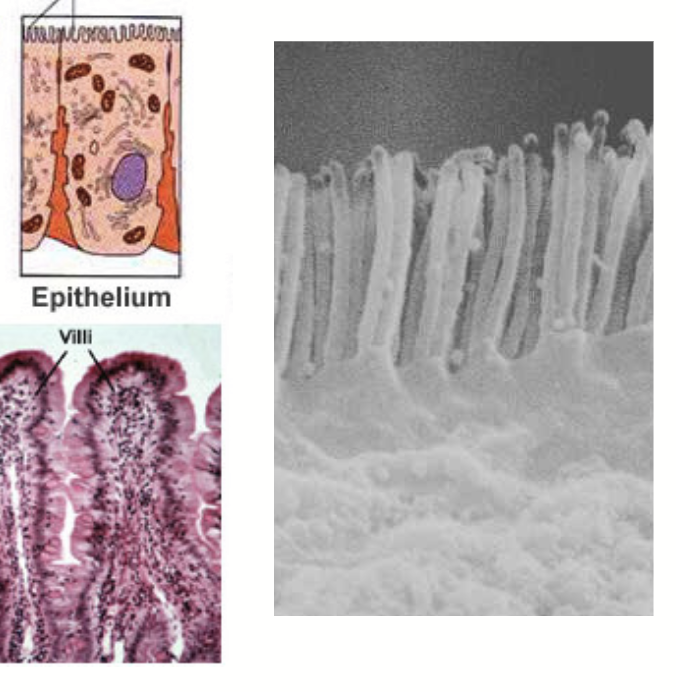
nutrient transport mechanisms
Passive transport:
Diffusion
Facilitated diffusion
Active transport
Will depend on the nutrient’s:
Solubility
Concentration gradient
Molecular size
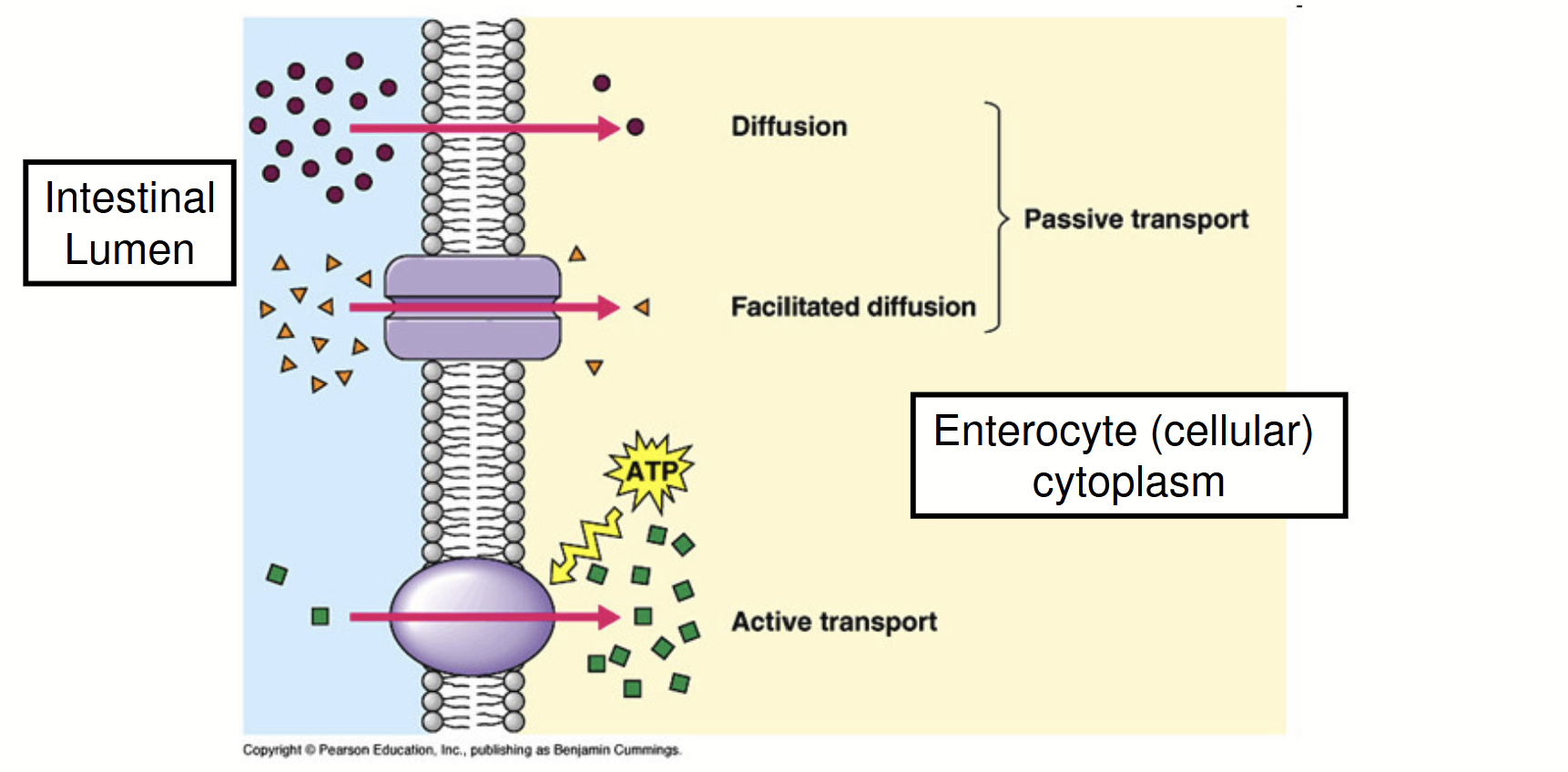
gut bacteria
~10 per cell in the body → 102-1012 bacteria/g content (region specific). 1000:1 anaerobic to aerobic (mostly anaerobic).
Very important for the fermentation of non-digestible CHO, producing many compounds (lactate, SCFA).
Determinants influencing number in various regions:
Regional oxygen level
pH
Bile acids
Gut transmit time
Mucus
Immune factors
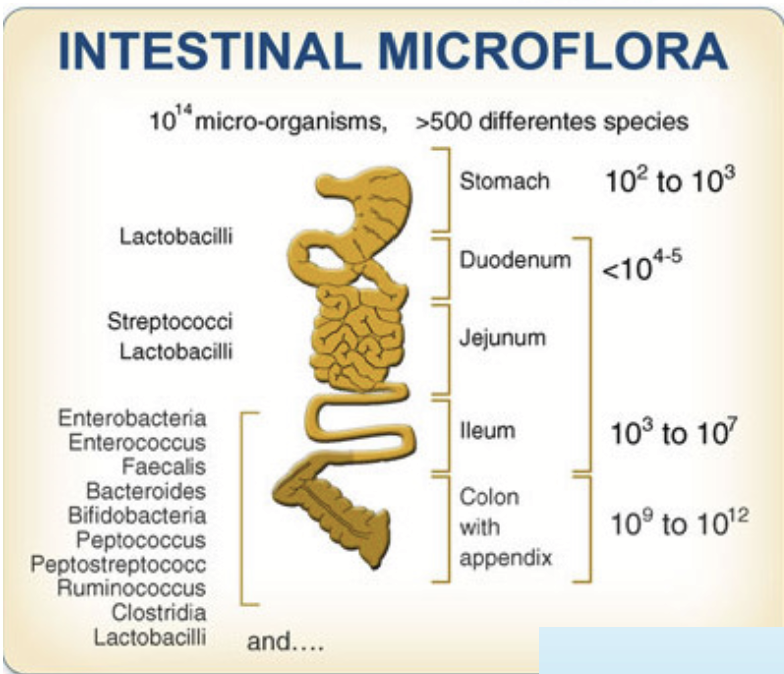
simple system with functional caecum
Key features:
“Pseudo-ruminant”
Hindgut fermenter
Functional caecum
All other regions of the gut function similar to the monogastric system
Suited for a diet with large amounts of fodder and foraging
Very, very high fibre foods → SCFA produced → provide bulk of energy for host!
e.g. horse, rabbit, hamster
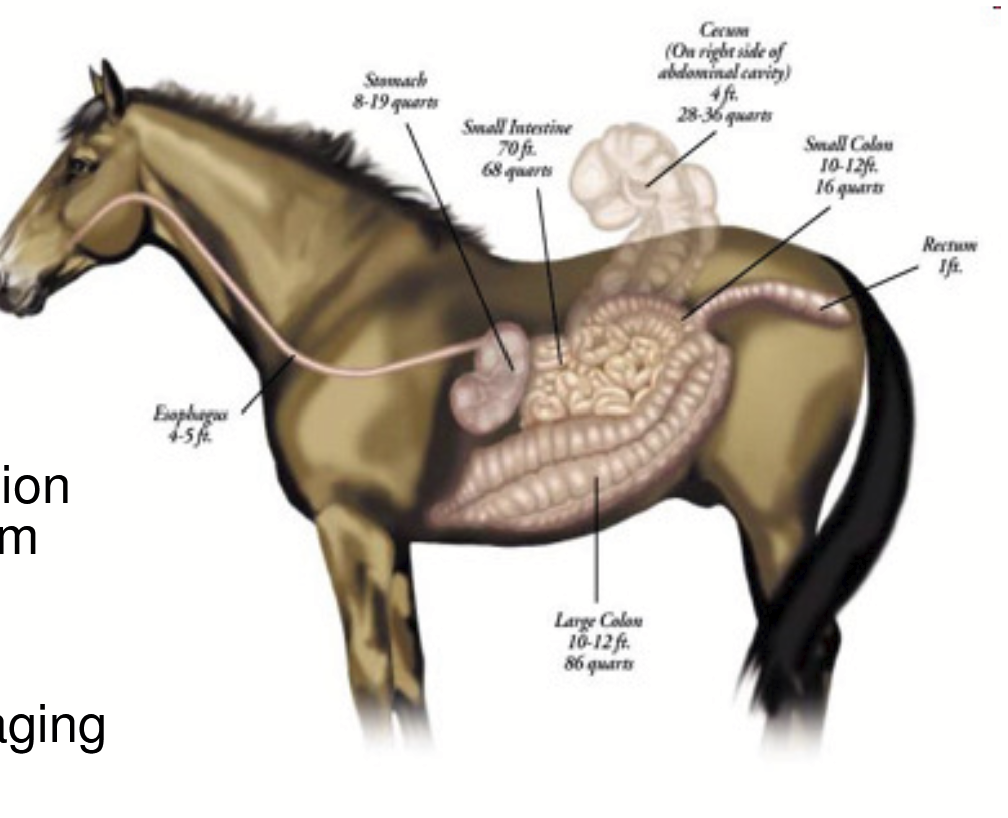
functional caecum
Enormous hindgut (20-30L capacity) filled with bacteria. SCFA provide 70% of total energy needs for host (bulk from hindgut fermentation). Site for the production of vitamins.
Signs of an energy or nutrient deficiency: coprophagy (eating dung/feces).
Young animals eating feces colonize their guts with bacteria.
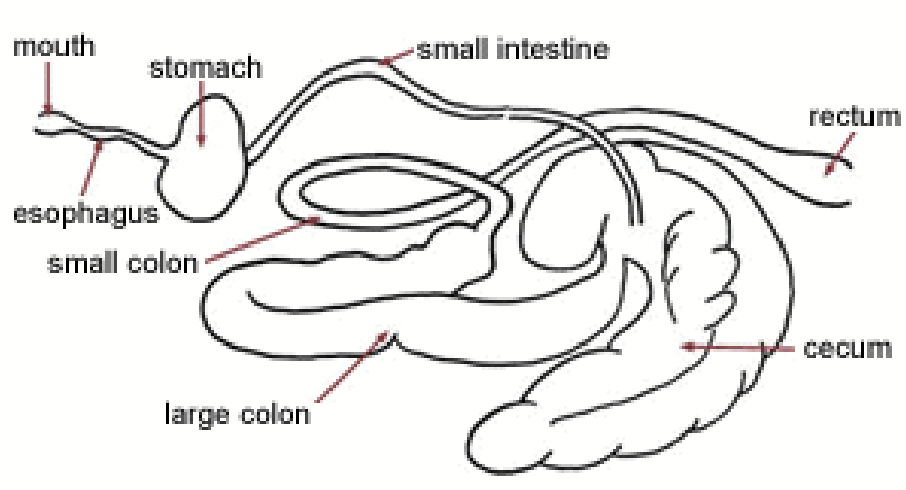
multiple system: ruminant
Key features:
Large stomach divided into four physically distinct regions: reticulum, rumen, omasum, abomasum
System highly suited for animals that eat a high quantity of fodder and forage plant materials
All other regions of the gut function similar to the monogastric system
Advantages:
Vitamin synthesis (e.g. B vitamins, vitamin K)
Non-protein nitrogen used for making protein → can feed low quality protein sources/non-protein nitrogen sources; bacteria can take nitrogen and incorporate it into amino acid synthesis
Disadvantages:
CHO degraded into gases and lost through eructation (methane gas) → huge amounts of belching = losing CHO
Heat production - fermentation produces heat (more NRG going into it); NRG lost via methane gas; need to consume more food to make up for loss
reticulum
Honeycomb appearance; can capture nutrients and trap foreign materials (wire, nails, etc.) that are accidentally swallowed (Can cause “hardware disease”).
Rich in bacteria (fermentation vat).
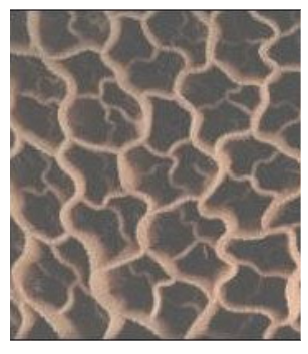
rumen
Attached to the reticulum; the largest section of the stomach.
Rich in bacteria (fermentation vat).
Papillae → increase surface area for absorption (like microvilli in human intestine).
Food is mixed and partially broken down and stored temporarily.
60-80% of total energy produced here as SCFA.
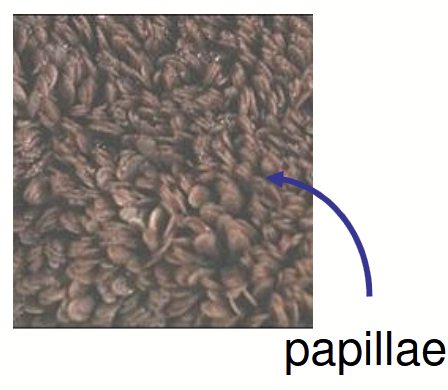
omasum
To the right of the animal.
Responsible for the resorption of water and some electrolytes.
Filters large particles.
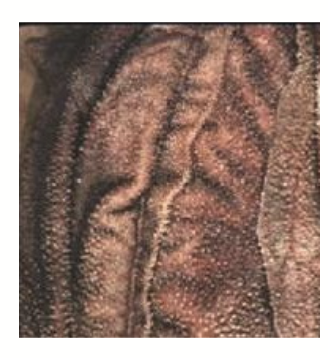
abomasum
The “true stomach” of a ruminant, similar to the stomach of monogastric animals.
Digestive enzymes secreted from gastric glands (HCl, mucin, pepsinogen, lipase, etc.).
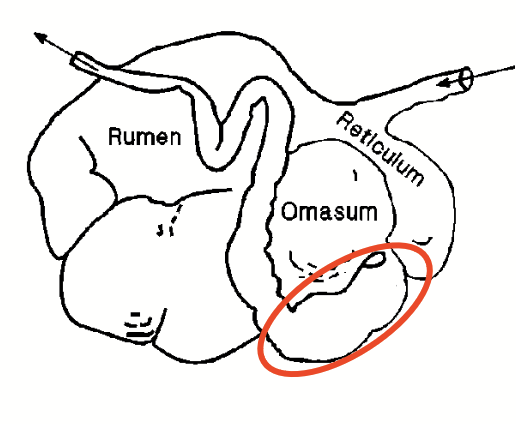
foregut digestion
Fermentation takes place before entering the intestine.
Nutrients produced by bacteria then become available for digestion and absorption by the ruminant.
rumination
A ruminant’s esophagus is bidirectional, allows the animal to regurgitate and chew cud to break it down into smaller pieces.
eructation (belching)
Foregut fermentation releases gases such as methane. Results in loss of CHO and energy.
avian system
Key features
Beaks and claws: important for breaking up (mechanical breakdown) foods into smaller pieces that they can swallow
Rapid digestion: can starve if deprived of food for even a short time (i.e., hours; must constantly be eating)
Small intestine functions similar to that in other systems
e.g. chicken, turkey, etc.
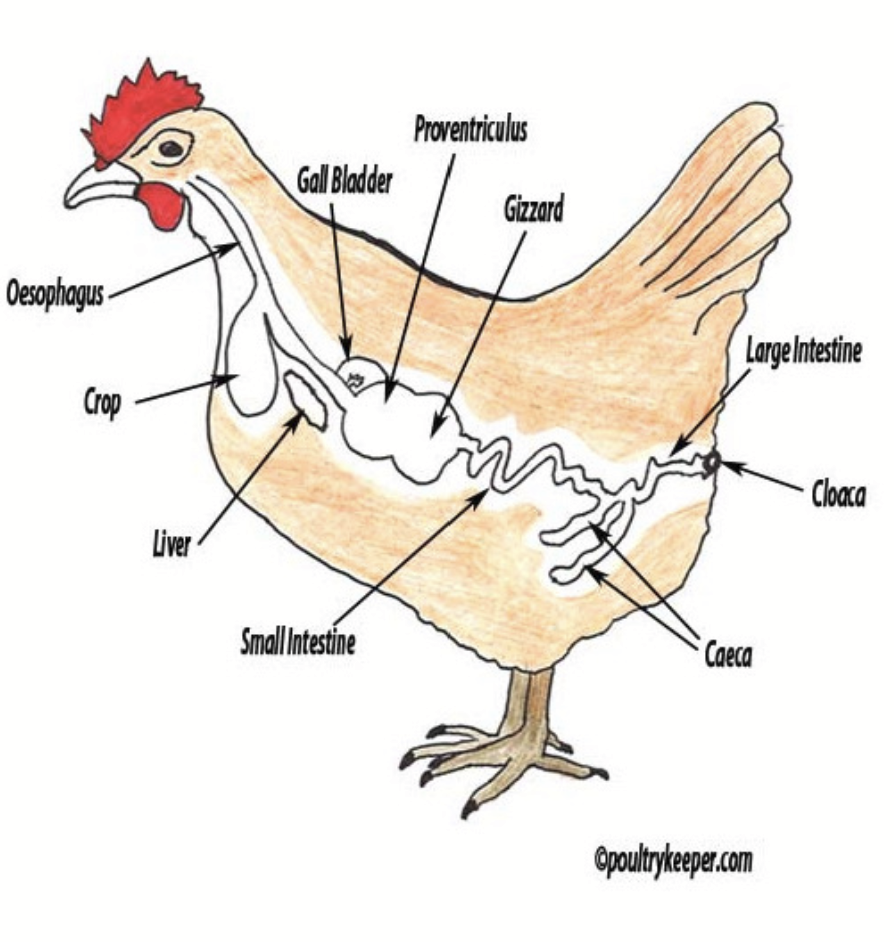
crop
Enlarged area of the esophagus where the bird can temporarily store food. Well developed in most species, but not all. Food will soften (mixed with liquid). If feeding baby birds, will regurgitate food from here.
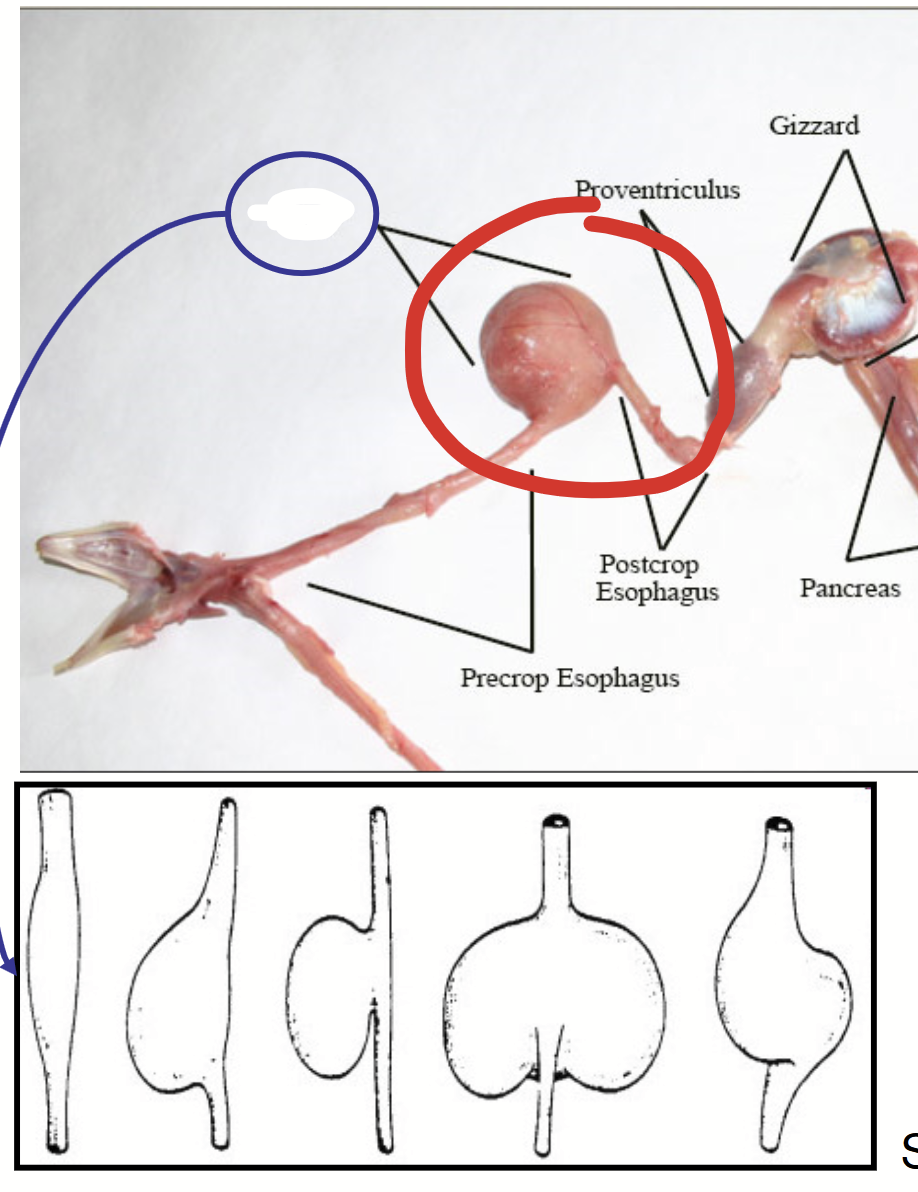
two-chamber stomach
Glandular portion: proventriculus.
Muscular portion: gizzard.
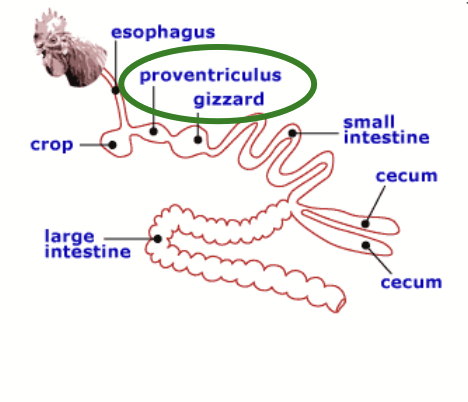
proventriculus
The glandular portion of a bird’s two-chamber stomach. Where chemical breakdown occurs. Gastric enzymes and HCl are secreted.
gizzard
The non-glandular portion of a bird’s two-chamber stomach. Grinds and digests touch food (mechanical breakdown).
Birds swallow rocks that settle here and will essentially “chew” to break down food. This allows food to mix more efficiently with enzymes.
ceca
Can be multiple in birds; minor site of bacterial fermentation. Not a huge component of nutrition for birds.
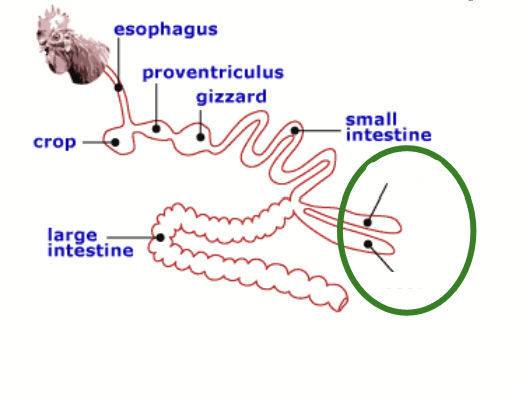
avian large intestine
Very short and serves predominantly to connect the small intestine and cloaca.
A bit of storage of undigested material.
Water absorption.
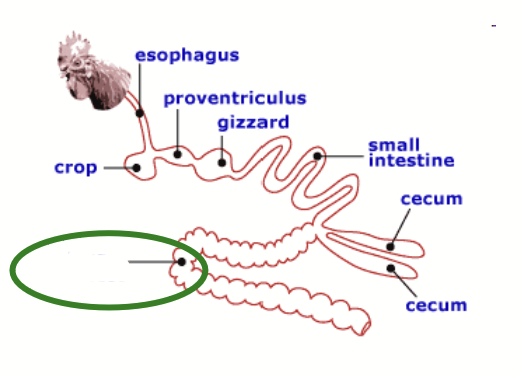
cloaca
Where the digestive, urinary, and reproductive systems meet.
Poop = uric acid from urinary tract that mixes with leftover food.
digestibility
The measure of the fraction of a specific nutrient (or of energy) that is extracted by the GI tract.
Understanding how much got in and how much is excreted!
Calculated from the amount of nutrient in the diet and the amount appearing in the feces.
Represents a combination of nutrient release from the food matrix, microbial fermentation (bacteria type change between species), and absorption.
Important: prevent deficiency and ensure essential nutrients are available to the organism.
Total Collection Method
Method to measure digestibility. The most laborious and challenging (need to adapt the animal), but the most accurate.
Allow the animal to adapt to the diet over a 7-21 day period.
Isolate the animal for quantitative analyses.
Measure intake over a 3-10 day period (must know EXACTLY how much goes in and out).
Collect and weigh all feces.
Analyze for nutrient of interest.
Find Apparent Digestibility Coefficient!

Apparent Digesibility Coefficient
The proportion of a nutrient taken into the digestive tract that is actually digested.
A = ratio of nutrient/marker in feed. B = ratio of nutrient/marker in feces.
Under-estimates true digestibility.
Not considered:
Endogenous secretions
Epithelial cells → GIT sheds, cells die every ~3 days and are replenished, contain nutrients that contribute to digestion.
e.g. fatty acids released from dying intestinal cells
Bacterial growth in gut
Nutrient synthesis
e.g. biotin produced by gut bacteria
Digestive enzymes (PROTEINS)
Protein secretion
e.g. digestive enzymes released by cells
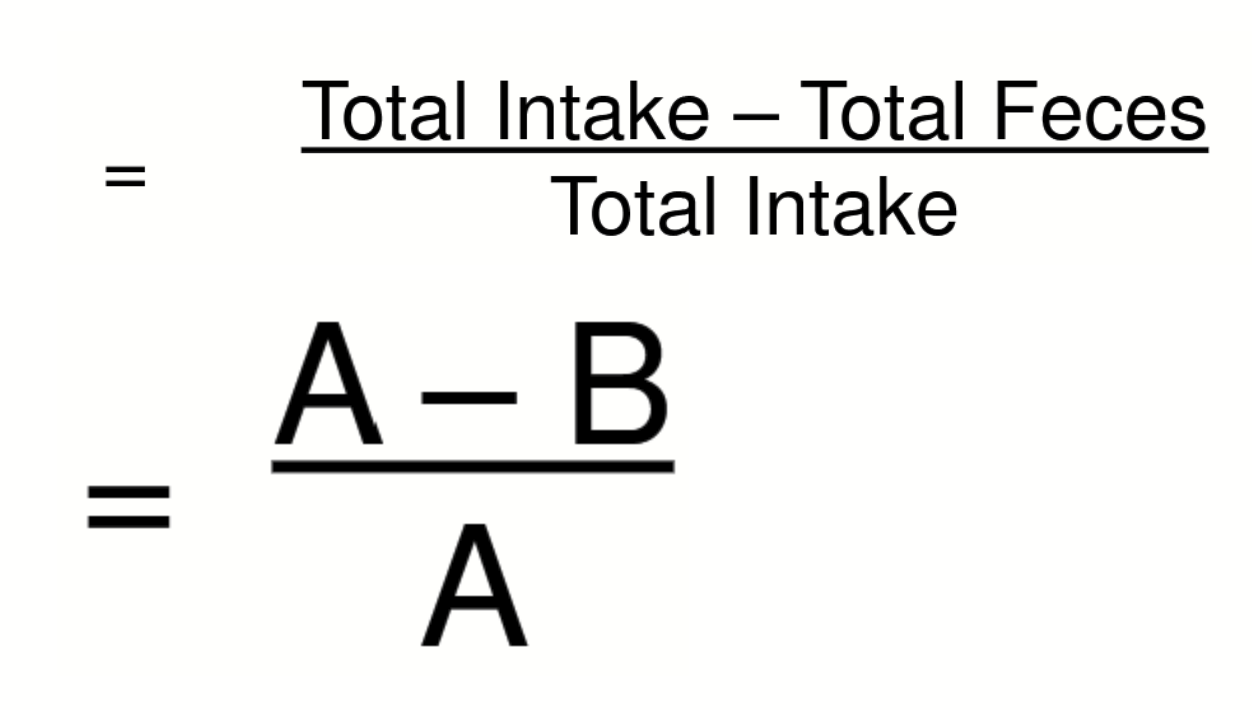
limitations of the Total Collection Method
Accuracy in measuring food intake (probably won’t be collecting intake properly → spills, etc.)
Metabolic cages create anxiety in animals, which may then behave abnormally (intake and excretion can change → inaccurate results)
Labour intensive (7-21 days!)
Animals confined in costly equipment
Not feasible for captive wild animals
metabolic cages
Containment method used to collect and analyze urine and feces.
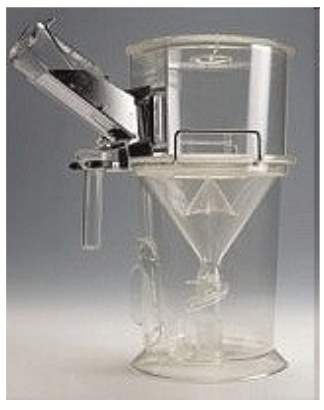
Indicator Method
Method used to measure digestibility, also referred to as the “Marker Technique”.
Requires a marker:
Internal (a natural component of the feed)
External (a component added to the feed)
Steps:
Adapt animal to test diet that contains a marker
Collect a feed and fecal sample
Analyze each for marker and nutrient of interest relative to your indicator
Find Apparent Digestibility Coefficient: A = ratio of nutrient/marker in feed. B = ratio of nutrient/marker in feces.
Advantages: less labour intensive, ideal for wild animals.

marker (used in indicator/marker technique)
Can be internal (natural component of feed) or external (component added to the feed).
Characteristics:
Non-absorbable (if it’s being absorbed, you won’t have accurate results of what’s being excreted).
Must not affect or be affected by the GIT.
Must mix easily with food (animals are picky).
Easily and accurately measured in samples (not costly, not labour intensive, etc).
e.g. ferric oxide, chromic oxide, silica, lignin (not fermentable/digestible).
true digestibility
Requires TWO DIETS!
Perform digestibility study using a TEST DIET.
Switch to diet containing none of the nutrient of interest (ZERO NUTRIENT DIET).
Analyze feces after TEST DIET is cleared.
Subtract level of nutrient in feces of animals fed the ZERO NUTRIENT DIET from the TEST DIET.
Affected by:
Feed intake
Particle size (some move faster/slower, if big and slow, won’t be absorbed properly)
Chemical composition
Climate (hot vs cold)
Age (older age, more stable dietary environment, better digestibility)
A = ratio of nutrient/marker in TEST DIET (what’s going in).
B = ratio of nutrient/marker in FECES (excreted).
C = ratio of nutrient/marker in FECES AFTER ZERO NUTRIENT DIET.

ATP
Cellular source of energy that is supplied by the macronutrients in the diet (carbs, fatty acids). Sustains physical energy, anabolism, active transport, etc.
Calorie
A measure of heat to express the energy content of food.
1 Food Calorie
1000 Chemistry calories.
4.18 KJ (kilojoules).
The energy required to raise the temperature of 1 kg (1L) of water by 1°C.
positive energy balance
Energy in > energy out (food and drink).
Weight gain/obesity
Infertility
Increased blood lipids
Insulin resistance
negative energy balance
Energy in < energy out (metabolic and cellular function, physical activity).
Weight loss
Infection
Loss of performance
Reduced bone mass
calorimetry
Measurement of heat production. Uses heat as an indicator of the amount of energy stored in the chemical bonds of foods (carbon-hydrogen bonds).
bomb calorimeter
Works according to the principles of direct calorimetry (i.e., directly measures the amount of energy stored in chemical bonds of foods).
Dry and weigh sample (~1g) and place in enclosed chamber with pure oxygen.
Sample is ignited.
Heat released is absorbed by water and measured.
Heat of combustion (gross energy)
Gross energy = maximum energy
Potential errors:
Overestimates energy: we do not digest food like a calorimeter (e.g. fibre) + human error (airtight, etc.)
Doesn’t take into account the energy needed for digestion and absorption
Digestibility!

Atwater values
The physiological fuel values of carbohydrates, fat, and protein.
CHO = 4 kcal/g
Fat = 9 kcal/g
Protein = 4 kcal/g
heat of combustion
The total energy released during a chemical reaction between a hydrocarbon and oxygen to release CO2, H2O and heat. The chemical structure (# of C-H bonds) of CHO, fat, and protein influences the outcome for macronutrients.
CHO: ratio of hydrogen to oxygen = 2:1.
Protein: has nitrogen, which affects gross energy measurement; however, in the body, N combines with H and is eliminated as urea - this loss of H affects the product.
Lipid: less oxidized than CHO and protein; ratio of H to O is much greater than 2:1; have lots of H atoms available for cleavage and oxidation for energy.
combustion of fatty acids
Releases more energy due to low initial oxidation and high H to O ratio.
Affected by:
Chain length: longer chain length releases more energy.
Degree of unsaturation: the more double bonds (less H), the less energy release (for equivalent length fatty acids).